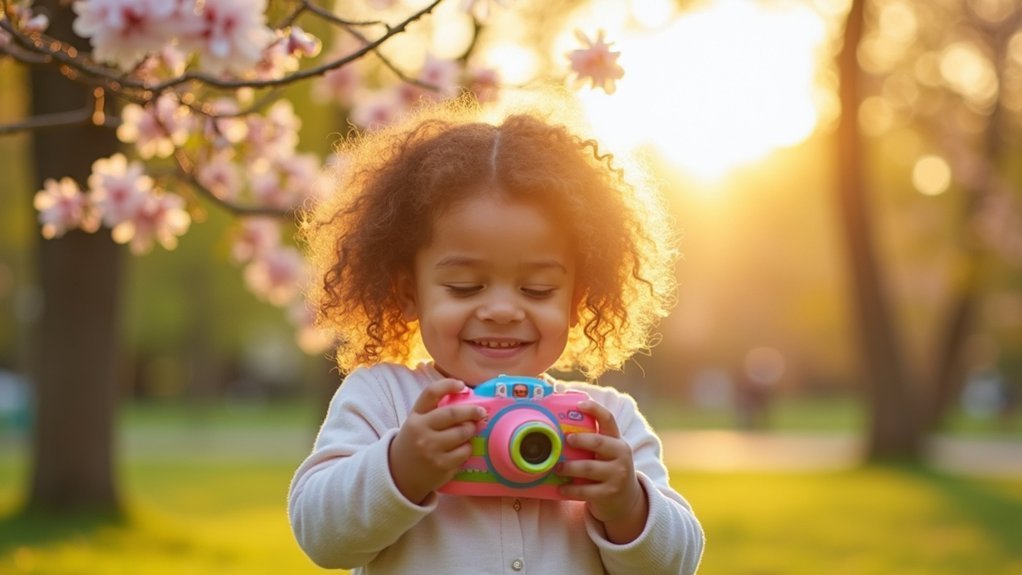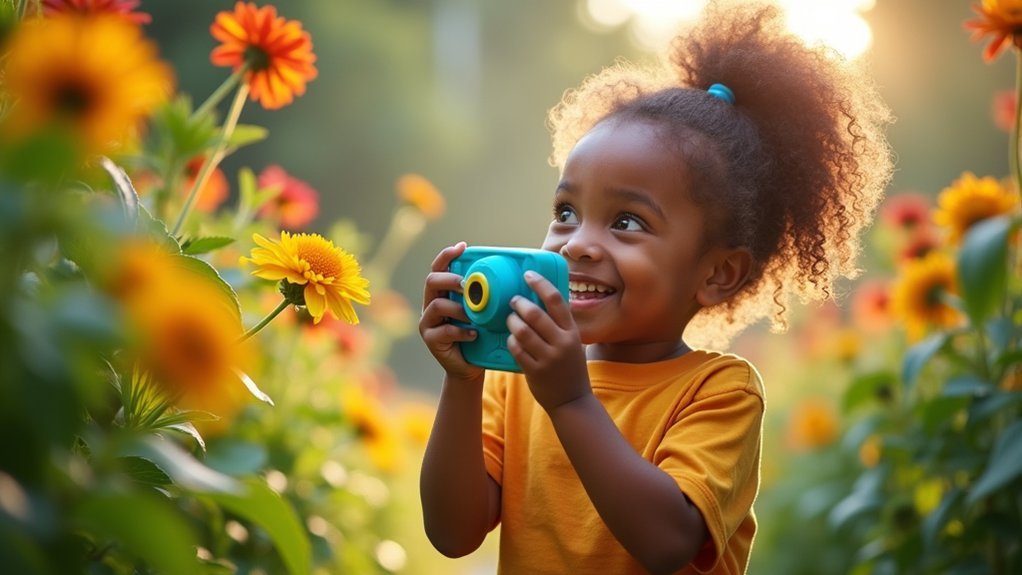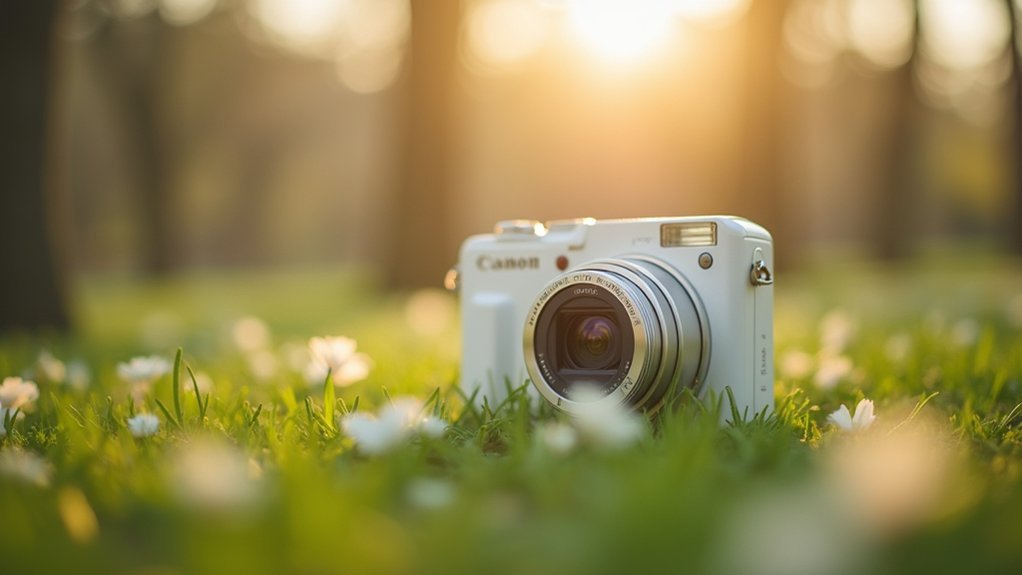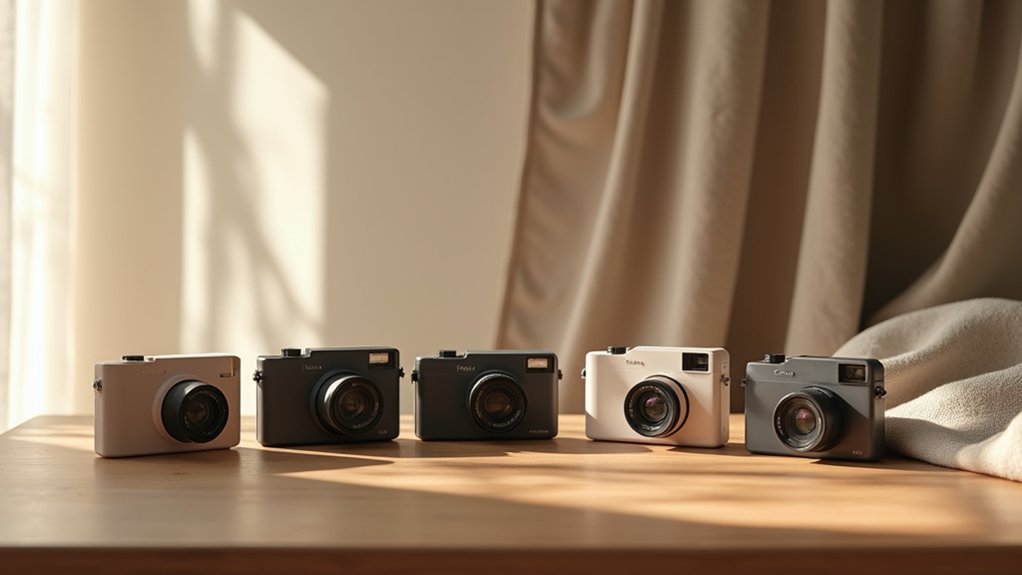For autistic photographers, these five sensory-friendly cameras offer excellent adaptability: Noise-Free Kidizoom with volume control and durable design; Polaroid Snap with silent operation and no bright screens; Ergonomic VTech Smartshot with well-spaced buttons for motor challenges; Light-Sensitive Nikon Coolpix with adjustable settings for visual comfort; and Canon PowerShot ELPH featuring straightforward menus and silent modes. Each camera balances functionality with sensory considerations to support your creative expression while minimizing potential triggers.
The Noise-Free Kidizoom: A Camera With Adjustable Sensory Features

Three key features make the Kidizoom camera line particularly suitable for autistic photographers: its durable construction, simplified interface, and customizable sensory elements.
The rubberized, shock-resistant design reduces anxiety about damaging equipment while providing a satisfying tactile experience. The camera is specifically designed to protect from drops and tumbles, making it ideal for photographers who may have motor control differences.
You’ll appreciate the straightforward controls that minimize cognitive load when taking photos. Many models include volume control options, allowing you to adjust or completely silence operational sounds that might otherwise trigger sensory discomfort.
The Kidizoom’s binocular-style design (in models like the Duo 5.0) creates a natural viewing experience, while the 4x digital zoom lets you capture detailed shots without physically approaching subjects.
With built-in memory expandable via SD cards, you can focus on photography without worrying about storage limitations.
Polaroid Snap: Instant Gratification Without Overwhelming Stimuli
The Polaroid Snap offers a uniquely calming photography experience for autistic individuals while delivering immediate tangible results.
You’ll appreciate its built-in Zink printer that produces 2×3 inch adhesive-backed photos instantly without computer connections.
The camera’s sensory-friendly design eliminates common triggers—no bright LCD screen, silent operation, and a gentle LED flash. Its simplified interface features just three color modes and an intuitive red shutter button, preventing decision fatigue. The optical viewfinder serves as an elegant on/off switch, providing a natural way to engage with the camera.
You’ll find the lightweight, ergonomic design comfortable to hold, with thoughtful details like a magnetic lens cap that won’t get lost.
The affordable price point and maintenance-free printing system (no ink cartridges to replace) make this an accessible option for photographers with sensory sensitivities who value both simplicity and immediate physical output.
The Ergonomic VTech Smartshot: Designed For Different Motor Skills

Designed with four key ergonomic features, VTech’s Smartshot camera accommodates diverse motor abilities through thoughtfully engineered controls.
Large, clearly shaped buttons are generously spaced to prevent frustration and support users with fine motor challenges. The lightweight, durable construction minimizes hand fatigue while the KidiZoom Duo’s 2.4″ color screen enhances visual engagement for children ages 3-9. The VTech brand prioritizes early childhood development with specially designed controls.
You’ll appreciate how the dual cameras simplify photography regardless of motor skill level. Motion control games and interactive voice effects provide accessible physical engagement without overwhelming sensory input.
The intuitive interface avoids complex menus, reducing cognitive load while maintaining creative freedom. With customizable volume settings and auto shut-off features, you can easily adjust sensory input to match individual needs and preferences.
Light-Sensitive Nikon Coolpix: Customizable Brightness For Visual Comfort
Nikon’s Coolpix series offers an impressive array of light-sensitivity controls that address a core challenge for autistic photographers: managing visual brightness.
You’ll find adjustable ISO settings that let you fine-tune light sensitivity to your exact comfort level.
Customize ISO settings to match your personal light sensitivity needs for a more comfortable shooting experience.
The customizable aperture, shutter speed, and exposure compensation features give you precise control over image brightness without overwhelming sensory input.
When lighting conditions change rapidly, you can rely on specialized scene modes that automatically adjust settings for visual comfort.
For low-light situations, you can reduce noise by adjusting ISO manually or using the camera’s noise reduction features.
The simplified interface on many Coolpix models minimizes sensory overload while still providing access to critical brightness controls.
White balance adjustments further enhance comfort by matching the camera’s color temperature to your visual preferences.
With the ISO range extending from ISO 100 to 102400 and beyond, these cameras provide exceptional high ISO sensitivity for shooting in dimly lit environments that might otherwise trigger sensory discomfort.
Canon PowerShot ELPH: Simple Interface With Minimal Sensory Triggers

Simplicity defines the Canon PowerShot ELPH’s interface, making it an exceptional choice for autistic photographers seeking minimal sensory triggers.
You’ll appreciate the straightforward menus and intuitive button layout that reduce cognitive overload while maneuvering the large 3.0-inch LCD screen.
The camera’s sensory-considerate physical design features a lightweight body with matte finish to minimize glare and tactile irritation. Its slim design makes it highly portable and easy to carry for photographers who may be sensitive to bulky equipment.
You can opt for silent shutter mode to decrease auditory input. The adjustable LCD brightness accommodates different lighting preferences, reducing visual discomfort.
Built-in Wi-Fi eliminates complex physical connections when sharing images.
Despite its simplicity, the PowerShot doesn’t sacrifice quality—its 20.2 MP sensor and DIGIC 4+ processor deliver excellent images while maintaining an accessible, low-stimulation photography experience.
Frequently Asked Questions
What Age Is Appropriate to Introduce Photography to Autistic Children?
You can introduce photography to autistic children as young as 5 years old, but you’ll need to match it with their individual sensory needs, interests, and readiness level rather than focusing only on age.
How Do I Prevent Camera-Related Meltdowns During Family Photography Sessions?
To prevent camera-related meltdowns, you’ll need to prepare children in advance, use noise-reducing cameras, take regular breaks, avoid flash photography, and follow their cues about when they’ve had enough exposure.
Can Photography Help With Sensory Regulation or Is It Stimulating?
Photography can both help regulate sensory experiences and be stimulating. You’ll find it calms through focused attention and control, but it may overwhelm if there’s too much visual input, sound, or tactile sensation.
Are Waterproof Cameras Less Overwhelming for Water-Sensitive Autistic Photographers?
Waterproof cameras can be less overwhelming for you if you’re water-sensitive because they eliminate anxiety about damage, allowing you to focus on photography without worrying about unexpected wetness triggering sensory discomfort.
How Does Shutter Sound Affect Different Sensory Processing Patterns?
Shutter sounds may overwhelm you if you’re hypersensitive, with sudden clicks triggering sensory distress. If you’re hyposensitive, you might barely notice them, while those with sensory seeking patterns might actually enjoy them.
In Summary
You’ve now discovered five cameras designed specifically for autistic photographers with sensory sensitivities. Whether you’re dealing with noise concerns, need immediate visual feedback, struggle with motor skills, have light sensitivity, or get overwhelmed by complex interfaces, there’s an option that’ll work for you. Remember, photography should be accessible to everyone—these sensory-friendly cameras guarantee you can capture the world through your unique perspective without discomfort.





Leave a Reply